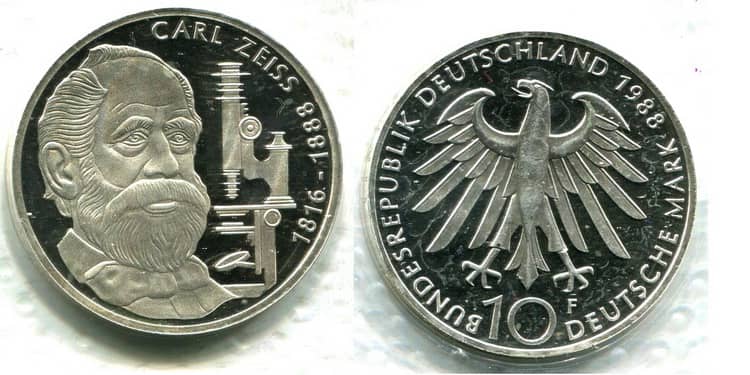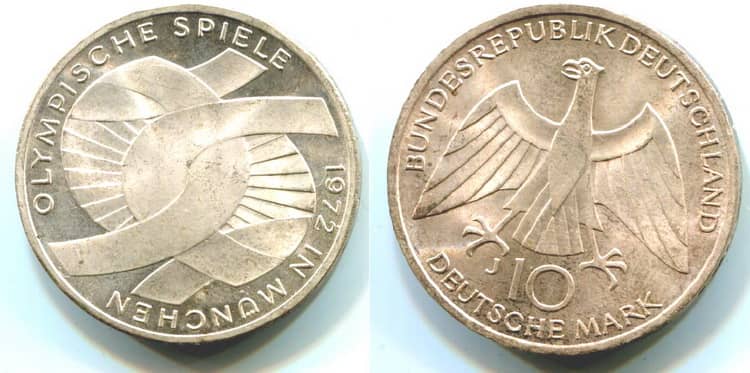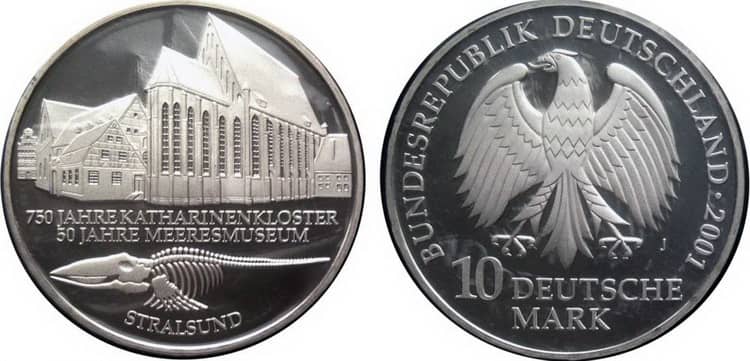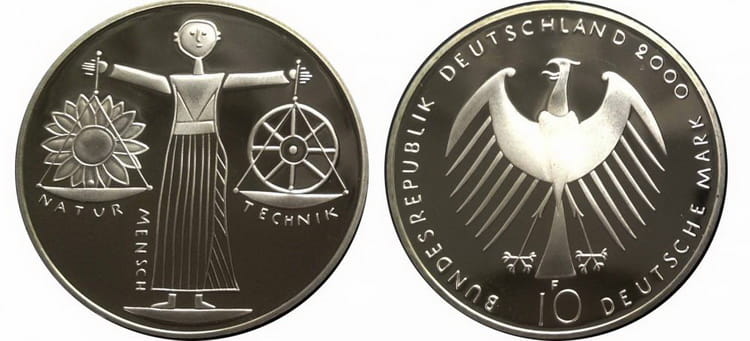
10 marks (Germany) is a series of commemorative and jubilee coins, produced from 1953 to 2001. During this period, only 87 variants of marks were issued, each of which highlights an important historical theme or event. The coins were produced in quality proof or uncirculated with a high content of silver. Such features attract collectors who collect German rare specimens.
History
The German mark is the monetary unit of Germany from 1948 to 2002. After World War II, the country’s territory was divided into four occupation zones – French, American, British (western) and Soviet (eastern). In 1948, in the western part – the Federal Republic of Germany – they introduced a mark and declared it a legal tender. The coin replaced the silver thaler, produced in Germany and Austria in the XVI – XIX centuries. In 1990, when the Federal Republic of Germany and the German Democratic Republic merged, the brand became a common currency. By that time, the national currency proved to be stable – in terms of popularity and confidence, it ranked second after the US dollar.

In 1953, commemorative coins were minted in Germany in 5, 10 and 20 marks denominations. The Mint produced a series of coins in denominations of “5 marks” with portraits of German personalities who glorified German territory over the past 500 years. These include coins with the image of Johann Gutenberg, Ludwig van Beethoven, Gerardus Mercator. Coins of 10 marks denomination appeared only in 1970.
Did you know? Before the Federal Republic of Germany and the GDR were united, there was strict control over movement between the two states on the territory of the GDR. Every citizen of eastern Germany who wished to go to West Germany had to receive permission from the government, and if he received it, then a trip could take no more than 100 marks in cash. Money changed at the rate of 10: 1.
The largest print run of 10 marks came out in 1972 in honor of the Olympics held in Germany:
- symbol of the Olympic Games;
- rays, spiral and the inscription Spiele der XX. Olympiade 1972 in Deutschland;
- rays, spiral and the inscription Spiele der XX. Olympiade 1972 in München;
- Olympic flame;
- athletes;
- stadium;
- node.

The first series of coins “Olympic Games” came out with the wrong transliteration of the inscription “Spiele der XX. Olympiade 1972 in Deutschland. The mistake was that the city where the games were held was not specified (Munich). The next series of coins came out with a correction. The edge of 10 German marks was decorated with an inscription in Latin “Citius, altius, fortius”, which means “Faster, higher, stronger”. In Germany, coins of 10 marks for the Olympic Games were minted from 1970 to 1972. The total circulation was 20,000,000 pieces as Uncirculated (ST) and 850,000 – Proof (SP).
Did you know? In 1980, the Soviet machine Lada 1200 was popular on the territory of the Federal Republic of Germany. The RSFSR produced cars for export to Germany. Basic equipment Lada cost 8,100 marks. German car companies also enjoyed popularity. Cheaper cost all Volkswagen 1200 L – 8 505 marks. The price for Italian Autobianchi A 112 was 8800 marks, and for Italian Fiat 126 – 6548 DM.
The next commemorative series of 10 marks was produced only in 1978. They continued to be minted until 1990. The coins were issued in large quantities (up to 8,000,000 copies as Uncirculated and 350,000 pieces as Proof). Every year at least two series of coins replenished the collection of coin collectors. Commemorative and commemorative samples of precious metals were considered legal tender only in the territory of Germany.
Important events in the life of Germany gave rise to the minting of 10 marks of 1978-1989:
- 1987 – 750th anniversary of the founding of Berlin;
- 1987 – 30th anniversary of the Treaty of Rome;
- 1988 – 200th anniversary of the birth of Arthur Schopenhauer;
- 1988 – 100th anniversary of the death of Carl Friedrich Zeiss;
- 1989 – 40th anniversary of the Federal Republic of Germany;
- 1989 – 2000th anniversary of the founding of Bonn;
- 1989 – 800th anniversary of the founding of Hamburg.

In 1990, commemorative coins of 10 marks of Germany received the status of legal tender in the territory of the GDR. In the united countries continued minting, increasing circulation. The number of copies as Uncirculated was 8-9.6 million units, as Proof – 450-500 thousand pieces.
Did you know? In the post-war period, a prohibition on certain professions was introduced in the FRG, products were issued by ration cards, and industry was destroyed. In addition, this part of the country was experiencing an economic crisis. Prices rose by 6%. By 1975, unemployment reached 1.2 million people, the purchasing power of the brand was reduced. To pay for housing left up to salary. In 1976, the country began to emerge from the crisis, and by 1985 it surpassed many Western states. The main assistant in the restoration of the country was Ludwig Erhard. Thanks to him, the brand ranked second in the ranking of prestigious currencies. He developed the “Marshall Plan” and monitored its implementation. Already by 1989, the country surpassed East Germany in terms of indicators. The monthly income of a German citizen reached 3300 marks, and the GDR – 1100 marks.
Since 1990, Germany has released several series of memorable 10 marks:
- 1990 – 800th anniversary of the death of Friedrich I Barbarossa;
- 1991 – 800th anniversary of the founding of the Teutonic Order;
- 1991 – 200th anniversary of the Brandenburg Gate;
- 1992 – 125th anniversary of the birth of Kathe Kollwitz;
- 1992 – 150th anniversaryof the Pour le Merite civil order;
- 1993 – 1000th anniversary of Potsdam;
- 1993 – 150th anniversary of Robert Koch;
- 1994 – 50th anniversary of German Resistance;
- 1994 – 250th birthday of Johann Gottfried Herder;
- 1995 – the beginning of the restoration of the Lutheran Church of the Virgin Mary;
- 1995 – 150th anniversary of the birth of Wilhelm Conrad Rontgen;
- 1995 – 800th anniversary of the death of Heinrich Leo.

Circulation
For the first 14 years, a total of five series of coins in denominations of 10 marks in small editions were minted; therefore, these coins are of particular value in the world of numismatics. Currently, imitations as Proof or Uncirculated are being released, but they are not of particular value to collectors.
10 marks “Olympics 1972” was published in the following editions:
- 1970 – Unc – 2,375,000 units, Proof – 125,000 pieces;
- 1971 – Unc – 4,875,000 units, Proof – 125,000 pieces;
- 1971 – Unc – 4,850,000 units, Proof – 150,000 pieces;
- 1972 – Unc – 4,850,000 units, Proof – 150,000 pieces;
- 1972 – Unc – 2,350,000 pieces, Proof – 125,000 pieces;
- 1972 – Unc – 4,850,000 pcs., Proof – 150,000 pieces.
A record number of 10 stamps as a Proof came out in 1998 – 5 * 200,000 pieces (five German mints participated in the production, each of which provided 200,000 samples of coins).
Cost of coins
In the numismatic market, the price of a memorable copy depends on the degree of preservation, the quality of coinage and the years of release. 10 stamps of 1972 as Unc cost $ USD 8-10, 1989 the “Hamburg port” of Germany – $ USD 5-10, and the sample of 1993 as a Proof is the same as the first two coins. It is noteworthy that the cost of a German bill of 10 stamps of 1933 will cost more – from $ USD 15.
Comments
No commens yet.